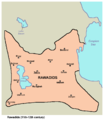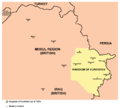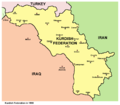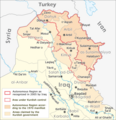List of Kurdish dynasties and countries: Difference between revisions
Appearance
Content deleted Content added
rv, this is just vandalism at this rate |
Frat070699 (talk | contribs) Zend origin Kurdish |
||
| Line 70: | Line 70: | ||
*[[Mokryan]] (1400–1800)<ref>The History of the Kurdish People:Hamma Mirwaisi [https://books.google.com.tr/books?id=Gp_YDwAAQBAJ&pg=PA562&lpg=PA562&dq=Bradost+emirate&source=bl&ots=URVRTCHRNc&sig=ACfU3U3bCfD690KRZz-Z1f6j46hGFEykNg&hl=tr&sa=X&ved=2ahUKEwj59J2kjdLpAhUdQkEAHSoaBlgQ6AEwCHoECAcQAQ#v=onepage&q=Bradost%20emirate&f=false]</ref> |
*[[Mokryan]] (1400–1800)<ref>The History of the Kurdish People:Hamma Mirwaisi [https://books.google.com.tr/books?id=Gp_YDwAAQBAJ&pg=PA562&lpg=PA562&dq=Bradost+emirate&source=bl&ots=URVRTCHRNc&sig=ACfU3U3bCfD690KRZz-Z1f6j46hGFEykNg&hl=tr&sa=X&ved=2ahUKEwj59J2kjdLpAhUdQkEAHSoaBlgQ6AEwCHoECAcQAQ#v=onepage&q=Bradost%20emirate&f=false]</ref> |
||
*[[Emirate of Şirvan]] (1264–1840s, [[Siirt]]) |
*[[Emirate of Şirvan]] (1264–1840s, [[Siirt]]) |
||
*[[Zand dynasty]] (1750-1794)[https://www.iranicaonline.org/articles/zand-dynasty] |
|||
<gallery> |
<gallery> |
||
File:Map of Roman dependency of Sophene, Corduene, Commagene, and Osrhoene as of 31 BC.png|Map showing the Roman dependency of Corduene (as of 31 BC) |
File:Map of Roman dependency of Sophene, Corduene, Commagene, and Osrhoene as of 31 BC.png|Map showing the Roman dependency of Corduene (as of 31 BC) |
||
Revision as of 01:05, 27 February 2021

This is a list of Kurdish dynasties, countries and autonomous territories. All of which flourished after the Islamic conquest of Persia and the bordering Roman provinces; before this, the term "Kurd" referred to Iranian nomads in the region, and modern academics do not accept that any earlier state or ruler is accurately described as Kurdish.[1][2][3]
Former states and dynasties
- Sadakiyans (770-827, Urmia)
- Aishanids (912–961)
- Daysam (938-955) [4]
- Hadhabani (943–1063, Urmia and Arbela)
- Rawadids (of Arab origin, later Kurdicized;[5] 955–1071, Tabriz and Maragheh)[6]
- Shaddadids (951–1199, Transcaucasia)[7]
- Hasanwayhids (959–1095, Kermanshah)[7]
- Marwanids (983–1096, Diyarbakir and Mosul)[7]
- Annazids (991–1117, Hulwan)[7]
- Hazaraspids (1155–1425)
- Ayyubid dynasty (1171–1341)[8]
- Zakarids (1186-1360)[9][10][11][12][13]
- Vassaldom of Ardalan (1169–1867)
- Emirate of Hazro-Sason (13th century-1839/40)[14]
- Emirate of Bingöl (1231–1864, Bingöl)[15]
- Emirate of Çemişgezek (13th century-1613, Çemişgezek)[16]
- Emirate of Bradost (1510–1609, Urmia)[17]
- Emirate of Miks (1514–1847, Van)[18][19]
- Shahkulu Sons (1548-1823,Salmas )[20]
- Tabriz Khanate (1747–1802)[21]
- Principality of Zirqan (1335-1835 )[22]
- Principality of Eğil (1049–1864, Diyarbakir)[23]
- Emirate of Pazooka (1499–1587, Malazgirt and Eleskirt)[24]
- Emirate of Hasankeyf (1232–1524, hasankeyf and Siirt)[25]
- Emirate of Kilis (1264–1611, Kilis and Aleppo)[26]
- Principality of Suleyman (1515–1838, Silvan and Kulp)[27][28]
- Principality of Mahmudi (1406–1839, Van)[29]
- Principality of Donboli (1210–1799, Van and Khoy)[30][31]
- Sarab Khanate (1747–1797)
- Khoy Khanate (1747–1813)[32]
- Emirate of Palu (1495–1845, Palu)[33]
- Emirate of Baban[34] (1649–1851,[35] region of Sulaymaniyah)[36]
- Emirate of Soran[34] (late 14th century–1851[citation needed], Rawanduz)[36]
- Emirate of Hakkâri[34] (14th century–1855, present-day southeastern Turkey)[36]
- Emirate of Bahdinan[34] (1339–1843, Amadiya)[36]
- Principality of Bitlis (1182–1847)
- Emirate of Bohtan[34] (1330–1855, Cizre, Jazira)[36]
- Mokryan (1400–1800)[37]
- Emirate of Şirvan (1264–1840s, Siirt)
- Zand dynasty (1750-1794)[4]
-
Map showing the Roman dependency of Corduene (as of 31 BC)
-
Ayyubid Empire 1193
-
Hasanwayhid dynasty (10th-11th century)
-
Khurasani Kurdish exclave circa 1835
-
Rawadid Dynasty
-
Marwanid Dynasty
Former countries
- Kingdom of Kurdistan (1921–1924 and 1925)
- Red Kurdistan Kurdistan Uyezd (1923–1929) and Kurdistan Okrug (1930)
- Republic of Ararat (1927–1930)
- Republic of Mahabad (1946–1947)
-
Provisions of the Treaty of Sèvres for an independent Kurdistan (in 1920)
-
Kingdom of Kurdistan in 1923
-
Red Kurdistan (1923–1929)
-
Republic of Mahabad, 1945-1946
Current
- Kurdistan Region (autonomous region in Iraq, 19 May, 1992–)
- Autonomous Administration of North and East Syria (self-proclaimed autonomous region declared during the Syrian Civil War by the PYD) (July 19, 2012–)
-
Iraqi Kurdistan in 1975
-
Iraqi Kurdistan in 1998
-
Iraqi Kurdistan in 2012
-
Modern Iraqi Kurdistan
See also
References
- ^ J. Limbert. (1968). The Origins and Appearance of the Kurds in Pre-Islamic Iran. Iranian Studies, 1.2: ss. 41-51.
- ^ G. Asatrian. (2009). Prolegemona to the Study of Kurds. Iran and the Caucasus, 13.1: ss. 1-58.
- ^ James, Boris. (2006). Uses and Values of the Term Kurd in Arabic Medieval Literary Sources. Seminar at the American University of Beirut, ss. 4, 8, 9.
- ^ https://www.iranicaonline.org/articles/daysam
- ^ Peacock, Andrew (2017). "RAWWADIDS". Encyclopaedia Iranica.
- ^ Jamie Stokes, Encyclopedia of the Peoples of Africa and the Middle East, Volume 1, Infobase Publishing, 2009, ISBN 978-0-8160-7158-6, p. 382.
- ^ a b c d Amir Hassanpour, Nationalism and Language in Kurdistan, 1918-1985, Mellen Research University Press, 1992, p. 50.
- ^ R. S. Humphreys, Ayyubids, "Encyclopaedia Iranica", (August 18, 2011),[1]
- ^ Alexei Lidov, 1991, The mural paintings of Akhtala, p. 14, Nauka Publishers, Central Dept. of Oriental Literature, University of Michigan, ISBN 5-02-017569-2, ISBN 978-5-02-017569-3, It is clear from the account of these Armenian historians that Ivane's great grandfather broke away from the Kurdish tribe of Babir
- ^ Vladimir Minorsky, 1953, Studies in Caucasian History, p. 102, CUP Archive, ISBN 0-521-05735-3, ISBN 978-0-521-05735-6, According to a tradition which has every reason to be true, their ancestors were Mesopotamian Kurds of the tribe (xel) Babirakan.
- ^ Richard Barrie Dobson, 2000, Encyclopedia of the Middle Ages: A-J, p. 107, Editions du Cerf, University of Michigan, ISBN 0-227-67931-8, ISBN 978-0-227-67931-9, under the Christianized Kurdish dynasty of Zak'arids they tried to re-establish nazarar system...
- ^ William Edward David Allen, 1932, A History of the Georgian People: From the Beginning Down to the Russian Conquest in the Nineteenth Century, p. 104, Taylor & Francis, ISBN 0-7100-6959-6, ISBN 978-0-7100-6959-7,She retained and leant upon the numerous relatives of Sargis Mkhargrdzeli, an aznauri of Kurdish origin
- ^ Vardan Arewelts'i's, Compilation of History In these time there lived the glorious princes Zak'are' and Iwane', sons of Sargis, son of Vahram, son of Zak'are', son of Sargis of Kurdish nationality (i K'urd azge') p. 82
- ^ Social Relations in Ottoman Diyarbekir, 1870-1915
- ^ Sebastian, Maisel (2018). The Kurds: An Encyclopedia of Life, Culture, and Society. p. 131. ISBN 9781440842573.
- ^ Kurdish notables and the Ottoman state: evolving identities, competing ..., p. 58, at Google Books By Hakan Özoğlu
- ^ Dehqan, Mustafa; Genç, Vural (2019). "The Kurdish Emirate of Brādōst, 1510-1609". Oriente Moderno. 99 (3). doi:10.1163/22138617-12340222. Retrieved 30 January 2021.
- ^ Aydın, Suavi; Verheij, Jelle (2012). Jorngerden, Joost; Verheij, Jelle (eds.). Social Relations in Ottoman Diyarbekir, 1870-1915. Brill. p. 27. ISBN 9789004225183.
- ^ Sinan Hakan: History of the Kurdish Mirchs of Müküs and Han Mahmud (Die Geschichte der kurdischen Fürsten von Müküs and Han Mahmud), Peri Verlag, Istanbul 2002, ISBN 9758245589
- ^ Yaşar kaplan,PINYANIŞ Government(university of Hakkari),page:1-44,[2]
- ^ Manoutchehr M. Eskandari-Qajar: Life at the Court of the Early Qajar Shahs, transl. and edit. from "Tarikh-e 'Azodi" by Soltan Ahmad Mirza 'Azod al-Dowleh, Mage Publishers, Washington 2014, pp. 140 ff.
- ^ Fatih, pekol (2017). Principality of Zirqan and History of Zirqan. Mardin Artuklu University.
- ^ Han, Şeref (Çev. İbrahim Sunkur) (2016). Şerefname. Van: Sîtav. p. 204. ISBN 978-605-66520-1-1.
- ^ Han, Şeref (Çev. İbrahim Sunkur) (2016). Şerefname. Van: Sîtav. p. 375. ISBN 978-605-66520-1-1.
- ^ Eppel, Michael (2018), Gunter, M. Michael (ed.), The Kurdish emirates: Obstacles or precursors to Kurdish nationalism?, Routledge, ISBN 9781317237983
- ^ Soyudoğan, Muhsin (September 2015). "Tribal Bandistry in Ottoman Ayntab (1690-1730)". Bilkent University: 39–42.
{{cite journal}}: Cite journal requires|journal=(help) - ^ Acikyildiz, Birgul (2014-08-20). The Yezidis: The History of a Community, Culture and Religion. I.B.Tauris. p. 48. ISBN 9781784532161.
- ^ E. J. Brill's (1913–1936), E. J. Brill's First Encyclopaedia of Islam, 4. cilt, vol. 3, pp. 1144–1145, ISBN 9004097902
- ^ Öztuna, Yılmaz (2005). States and dynasties. Vol. 1. Ankara. p. 522.
- ^ Oberling, Pierre. "DONBOLI". Encyclopaedia Iranica. Retrieved 2011-11-29.
- ^ Veysel Başçı, “History and Historical Chronicles of Dunbuli Principality [XIII-XVIII. YY.] ”, Kadim Akademi SBD, C. 3, S. 2, 2019, p. 63
- ^ Oberling, Pierre. "DONBOLI". Encyclopaedia Iranica. Archived from the original on 2016-11-17. Retrieved 2011-11-29.
- ^ Nusret Aydın, Diyarbakır and Mirdasiler History, 2011, p. 304-305
- ^ a b c d e Gérard Chaliand, A People Without a Country: The Kurds and Kurdistan, Zed Books, 1993 pp. 17-18.
- ^ BĀBĀN, Kurdish princely family in Solaymānīya, Iranica
- ^ a b c d e Hirmis Aboona, Assyrians, Kurds, and Ottomans: Intercommunal Relations on the Periphery of the Ottoman Empire, Cambria Press, 2008, ISBN 978-1-60497-583-3, p. 160.
- ^ The History of the Kurdish People:Hamma Mirwaisi [3]















